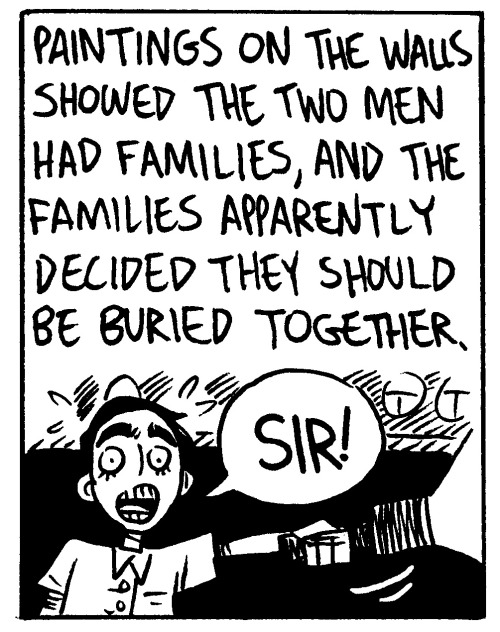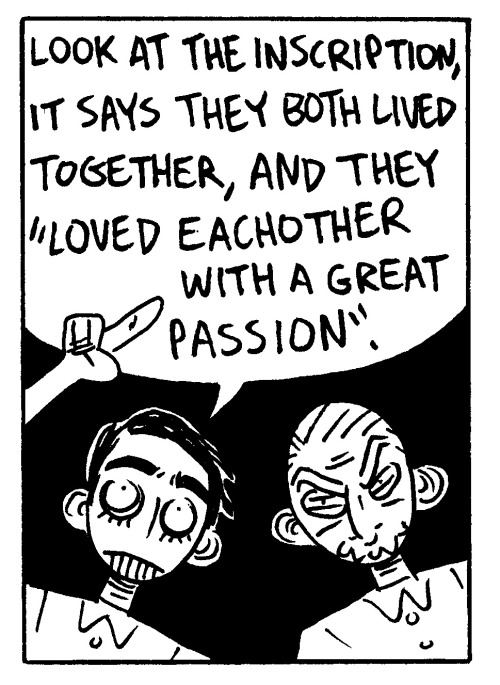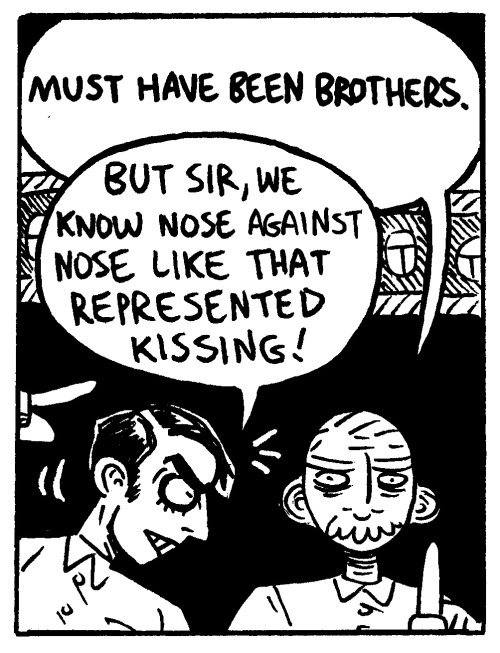ani-bester:thatlittleegyptologist:rudjedet:somecunttookmyurl:kimbleeofficial:vaspider:kingscrown666:
ani-bester:thatlittleegyptologist:rudjedet:somecunttookmyurl:kimbleeofficial:vaspider:kingscrown666:speedygal:queerrilla:sweaterkittensahoy:postmodernmulticoloredcloak:aeacustero:samandriel:kendrajk:Informative Ancient Egypt Comics: BROSOur 1st place contest winner requested a Niankhkhnum and Khnumhotep comic as their prize.I took a class about Ancient Egypt last semester and we had a whole lecture dedicated to talking about how gay Niankhkhnum and Khnumhotep were. Their tomb walls were decorated with scenes of them ignoring their wives in favor of embracing each other. In one scene, the couple is seated at a banquet table that is usually reserved for a husband and wife. There’s an entire motif of Khnumhotep holding lotus flowers which in ancient Egyptian tradition symbolizes femininity. Khnumhotep offers the lotus flower to Niankhkhnum, something that only wives were ever depicted as doing for their husbands. In fact, Khnumhotep is repeatedly depicted as uniquely feminine, being shown smaller and shorter than his partner Niankhkhnum and being placed in the role of a woman. Size is a big deal in Egyptian art, husbands are almost always shown as being larger and taller than their wives. So for two men of equal status to be shown in once again, a marital fashion, is pretty telling. Not to mention they were literally buried together which is the strongest bond two people could share in ancient Egypt, as it would mean sharing the journey to the afterlife together. And yet 90% of the academic text about these two talks about these clues in vague terms and analyze the great “brotherhood” they shared, and the enigma of Khnumhotep being depicted as feminine. Apparently it’s too hard for archaeologists to accept homosexuality in the ancient world, as well as the possibility of trans individuals.On the last note, I was walking around the Field Museum of Natural History in Chicago and there is a mummy on exhibit. It caught my attention because the panel that was describing it was talking about how it was a woman’s body in a male coffin and wow, the Egyptian working that day really screwed that up. My summary, not actual words, sorry I can’t remember verbatim but it basically said that someone screwed up.They claimed that the Egyptians screwed up a burial.The Egyptians. Screwed up. A burial.Now I’m not an expert in Ancient Egypt but from what I know, and what the exhibit was telling me, burials and the afterlife and all that jazz DEFINED the Egyptian religion and culture. They don’t just ‘screw up’. So instead of thinking outside the box for two seconds and wonder why else a genetically female body was in a male coffin, the ‘researchers’ blatantly disregard the rest of their research and decided to call it a screw up. Instead of, you know, admitting that maybe this mummy presented as male during his life and was therefore honorably buried as he was identified. But it would be too much of a stretch to admit that a transgender person could have existed back then.(Sorry I can’t find any sources online and it’s been like 2 years but it stuck in my mind)There’s a lot of bigoted historian dragging on my dash these days and it makes me happy.Once again, more proof that we queers have ALWAYS been here, and it’s a CHOSEN narrative to erase them.Reblog because ancient gay powerALWAYS. REBLOG. THIS. And also ancient gay power.Ancient Gay Power@somecunttookmyurl Lmao “they didn’t screw up”. They screwed up burials ALL THE TIME. ALL. THE. TIME. They also re-used coffins and ENTIRE TOMBS all. the. time. If you think death was the most important thing to Egyptians you know LESS than nothing about Egyptians.“now I’m not an expert about ancient Egypt”yes, it showsScrewed up burials. Re-used old coffins (honestly once you were past 100 years dead your coffin was fair game. Suck it). We’ve even got cases where a coffin had been made for the matriarch of the family, and then her teenage son dies before her. Because wood was expensive, and coffins took a long time to make, the family went ‘ok niankhamun is going in nesmut’s coffin’ and buried him that way. Then we get to the Late Period archaising and oh boy do we have some fun. Due to the Egyptian habit of being nostalgic for what they considered better periods of their history (oh wait where have I heard that before?) they tended to try to copy ‘styles’ of art from other periods without knowing the full decorum. So, as is the case with the Late Period, it’d become a mish mash of ‘ok so this is Amarna style paunch art, but we’re using the feminine coffin pose from the New Kingdom, and our art grid is off by one so everyone looks elongated’. They literally write about themselves being proud of copying these older art styles. I know this site likes to think in black and white terms, with a heavy amount of anti-intellectual bias, but reality is more complicated than you’d like, as is history. Knowing the full cultural context for why historical people did what they did is vital, because otherwise we assume they thought the same way we do about topics such as this, and that’s where you fall into the ‘bias’ trap. If you don’t look at something in Ancient Egypt and say ‘well what do the Egyptians themselves tell us about this’ and just immediately head to ‘well it’s this way now so archaeologists must have missed something what idiots’ then you’re doing a bad job of working with the material presented to you. As for Niankhkhnum and Khnumhotep, well this site likes to twist their narrative pretty hard, as you can see from the above. Yeah, they’re mlm couple. That’s been the accepted narrative (bar a few outliers) for about 40 years, and it was even suggested way before that. Idk, might be a good idea to read something written after 1970 if you’re trying to get current thinking on the subject. Or you know, stuff published this century. Basing your ideas of what archaeologists think currently on publications from the 60s is as bad as assuming that scientists now have the same ideas about disease as they did in the 60s. Things move on. Niankhkhnum and Khnumhotep are not depicted as different sizes, thus making one more ‘feminine’. They’re depicted as the same size, because it’s not just your gender in Egyptian art decorum that determines your size but also your rank and power. Look:Here they are embracing, in what is a depiction of a kiss. They’re the same size. Here they are at the entrance. Same size. Here they are kissing again. Same size. One last time. Same size. (I’ve been to this tomb. Seen it in person. It’s very gay)There are also loads of examples where women are not depicted as ‘small’, in fact that statement in and of itself is rather a generalisation than the actual rule. Here’s Menna and his wife:Same size. Here’s Inherkhau and his wife and children:Same size. And because I’m feeling petty, have one more. Here’s Irynefer and his wife:Same. Size. Idk about you guys, but doesn’t seem right does it? Really, size in these tomb paintings is all about the importance of the figure, in this case the deceased, rather than their gender. The only reason they would be not of the same size in the tomb is when one is as an Osiris. When that happens the figure who is larger, and yeah it’s usually the man because you rarely get women’s tombs because they’re buried with their husbands, is representative of the deceased being ‘honoured’ as an ‘Osiris’ (you become an Osiris after death in Egypt). The size of the person depicts their importance as the revered deceased and not because one is a woman. Take here for example the tomb of Sennefer:You can see Sennefer as the revered dead on the right, being offered a lotus (I’ll get onto that in a sec) by his wife. She’s offering him rebirth. It is only this scene in which she is depicted smaller, because on the left (at an angle) you can see them both….portrayed as the same size. Here’s another image of them together:It is only when she is offering to him as a revered, and more important, deceased person that she is smaller. Decorum dictates that the more important you are the larger you are, so the tomb owner will always be depicted as larger than pretty much everyone else. If Khnumhotep is offering a lotus flower to Niankhkhnum, it is because Niankhkhnum at that point is the revered dead. It has nothing to do with Khnumhotep being ‘feminine’. The narrative that one of them must be taking the ‘feminine’ role seems kinda….not good? As for the symbol of a lotus flower? That’s nothing to do with ‘femininity’. At all. In Egyptian culture, the lotus flower symbolised power and rebirth, as in one creation myth, the mound grew from the waters of Nun, and from this mound grew a lotus flower. When this lotus flower opened it provided the first ‘man’ and that’s how mankind came into existence. This is why we have a statue of Tutankhamun emerging from a Lotus flower. Khnumhotep offering this flower to Niankhkhnum is not symbolising his ‘femininity’ it’s offering him rebirth into the afterlife. A symbol that was extremely important in Ancient Egypt. Oh and finally, Archaeologists from 1964, and up until the early 80s, thought they were brothers because that’s literally what they refer to each other as. They call each other ‘sn=i’ ‘my brother’. Yeah it seems obvious now that they’re not, but when you start translating something you’re not looking at anything deeper. If it says they were brothers, and they themselves have said this, why would we think differently? It was not until the mid 70s when we worked out that Middle Egyptian Hieroglyphs (though they’re using Old Egyptian, but the flaw is the same) has limited words for family. We only have words for: father, mother, brother, sister, son, daughter, husband, and wife. There are no words for ‘uncle’ or ‘cousin’ or ‘nephew’. So we ended up having to go back and reassess some stuff, and it turned out where someone had said ‘so and so is my father’ they’re actually saying ‘so and so is my grandfather or uncle’ and the same goes for ‘son/nephew’, cousins are brothers and sisters. Yes, there was some absolute homophobia going on when it was first suggested that they might not actually be brothers, but lovers. There are some that still think this way. But the vast majority no longer hold this view, and haven’t since the 1980s. Here is a link to everything we currently know about the presence of LGBT individuals in Ancient Egypt. It’s written by an excellent Egyptologist (Deborah Sweeney), and has an extensive bibliography on everything written so far about LGBT individuals in Ancient Egypt often by LGBT Egyptologist and Archaeologists themselves. The PDF is free to read, and was published in 2011.Please stop believing that the homophobia of 1920s, or even 1970s, scholars is still the most current and widely held belief in Egyptology. By perpetuating this view, you harm those scholars, many of whom are LGBT themselves, who are trying to get out there and make themselves heard on this topic. They’re working tirelessly to change this perception and the narrative Tumblr likes to push is actively harming their work. Making this truth bigger for those in the back..“I know this site likes to think in black and white terms, with a heavy amount of anti-intellectual bias, but reality is more complicated than you’d like, as is history. ” -- source link
Tumblr Blog : kendrajk.tumblr.com
#ancient egypt









